Oisín Nolan
Semantic Diffusion Posterior Sampling for Cardiac Ultrasound Dehazing
Aug 24, 2025Abstract:Echocardiography plays a central role in cardiac imaging, offering dynamic views of the heart that are essential for diagnosis and monitoring. However, image quality can be significantly degraded by haze arising from multipath reverberations, particularly in difficult-to-image patients. In this work, we propose a semantic-guided, diffusion-based dehazing algorithm developed for the MICCAI Dehazing Echocardiography Challenge (DehazingEcho2025). Our method integrates a pixel-wise noise model, derived from semantic segmentation of hazy inputs into a diffusion posterior sampling framework guided by a generative prior trained on clean ultrasound data. Quantitative evaluation on the challenge dataset demonstrates strong performance across contrast and fidelity metrics. Code for the submitted algorithm is available at https://github.com/tristan-deep/semantic-diffusion-echo-dehazing.
Patient-Adaptive Focused Transmit Beamforming using Cognitive Ultrasound
Aug 12, 2025Abstract:Focused transmit beamforming is the most commonly used acquisition scheme for echocardiograms, but suffers from relatively low frame rates, and in 3D, even lower volume rates. Fast imaging based on unfocused transmits has disadvantages such as motion decorrelation and limited harmonic imaging capabilities. This work introduces a patient-adaptive focused transmit scheme that has the ability to drastically reduce the number of transmits needed to produce a high-quality ultrasound image. The method relies on posterior sampling with a temporal diffusion model to perceive and reconstruct the anatomy based on partial observations, while subsequently taking an action to acquire the most informative transmits. This active perception modality outperforms random and equispaced subsampling on the 2D EchoNet-Dynamic dataset and a 3D Philips dataset, where we actively select focused elevation planes. Furthermore, we show it achieves better performance in terms of generalized contrast-to-noise ratio when compared to the same number of diverging waves transmits on three in-house echocardiograms. Additionally, we can estimate ejection fraction using only 2% of the total transmits and show that the method is robust to outlier patients. Finally, our method can be run in real-time on GPU accelerators from 2023. The code is publicly available at https://tue-bmd.github.io/ulsa/
High Volume Rate 3D Ultrasound Reconstruction with Diffusion Models
May 28, 2025Abstract:Three-dimensional ultrasound enables real-time volumetric visualization of anatomical structures. Unlike traditional 2D ultrasound, 3D imaging reduces the reliance on precise probe orientation, potentially making ultrasound more accessible to clinicians with varying levels of experience and improving automated measurements and post-exam analysis. However, achieving both high volume rates and high image quality remains a significant challenge. While 3D diverging waves can provide high volume rates, they suffer from limited tissue harmonic generation and increased multipath effects, which degrade image quality. One compromise is to retain the focusing in elevation while leveraging unfocused diverging waves in the lateral direction to reduce the number of transmissions per elevation plane. Reaching the volume rates achieved by full 3D diverging waves, however, requires dramatically undersampling the number of elevation planes. Subsequently, to render the full volume, simple interpolation techniques are applied. This paper introduces a novel approach to 3D ultrasound reconstruction from a reduced set of elevation planes by employing diffusion models (DMs) to achieve increased spatial and temporal resolution. We compare both traditional and supervised deep learning-based interpolation methods on a 3D cardiac ultrasound dataset. Our results show that DM-based reconstruction consistently outperforms the baselines in image quality and downstream task performance. Additionally, we accelerate inference by leveraging the temporal consistency inherent to ultrasound sequences. Finally, we explore the robustness of the proposed method by exploiting the probabilistic nature of diffusion posterior sampling to quantify reconstruction uncertainty and demonstrate improved recall on out-of-distribution data with synthetic anomalies under strong subsampling.
Deep Generative Models for Bayesian Inference on High-Rate Sensor Data: Applications in Automotive Radar and Medical Imaging
Apr 16, 2025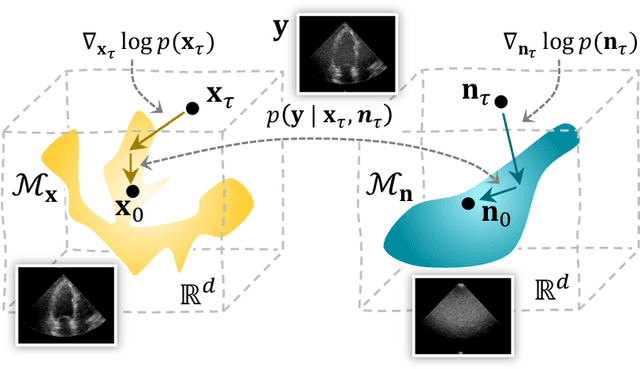
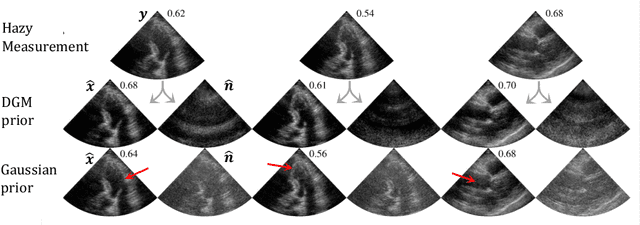
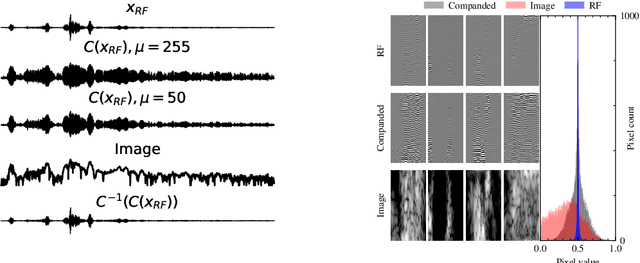
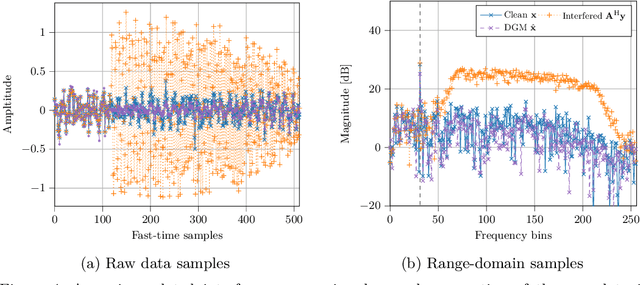
Abstract:Deep generative models have been studied and developed primarily in the context of natural images and computer vision. This has spurred the development of (Bayesian) methods that use these generative models for inverse problems in image restoration, such as denoising, inpainting, and super-resolution. In recent years, generative modeling for Bayesian inference on sensory data has also gained traction. Nevertheless, the direct application of generative modeling techniques initially designed for natural images on raw sensory data is not straightforward, requiring solutions that deal with high dynamic range signals acquired from multiple sensors or arrays of sensors that interfere with each other, and that typically acquire data at a very high rate. Moreover, the exact physical data-generating process is often complex or unknown. As a consequence, approximate models are used, resulting in discrepancies between model predictions and the observations that are non-Gaussian, in turn complicating the Bayesian inverse problem. Finally, sensor data is often used in real-time processing or decision-making systems, imposing stringent requirements on, e.g., latency and throughput. In this paper, we will discuss some of these challenges and offer approaches to address them, all in the context of high-rate real-time sensing applications in automotive radar and medical imaging.
Sequential Posterior Sampling with Diffusion Models
Sep 09, 2024


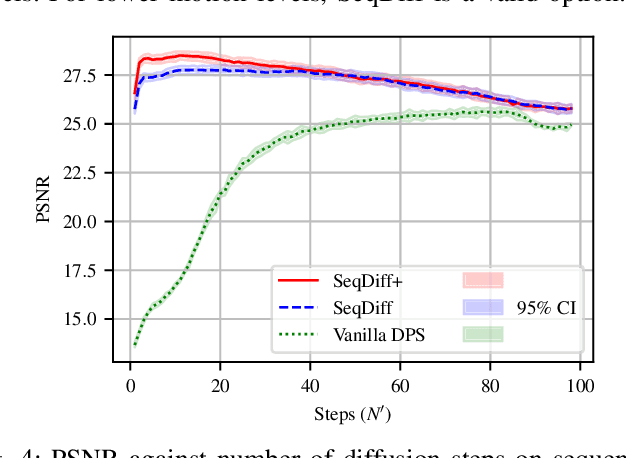
Abstract:Diffusion models have quickly risen in popularity for their ability to model complex distributions and perform effective posterior sampling. Unfortunately, the iterative nature of these generative models makes them computationally expensive and unsuitable for real-time sequential inverse problems such as ultrasound imaging. Considering the strong temporal structure across sequences of frames, we propose a novel approach that models the transition dynamics to improve the efficiency of sequential diffusion posterior sampling in conditional image synthesis. Through modeling sequence data using a video vision transformer (ViViT) transition model based on previous diffusion outputs, we can initialize the reverse diffusion trajectory at a lower noise scale, greatly reducing the number of iterations required for convergence. We demonstrate the effectiveness of our approach on a real-world dataset of high frame rate cardiac ultrasound images and show that it achieves the same performance as a full diffusion trajectory while accelerating inference 25$\times$, enabling real-time posterior sampling. Furthermore, we show that the addition of a transition model improves the PSNR up to 8\% in cases with severe motion. Our method opens up new possibilities for real-time applications of diffusion models in imaging and other domains requiring real-time inference.
Off-Grid Ultrasound Imaging by Stochastic Optimization
Jul 02, 2024Abstract:Ultrasound images formed by delay-and-sum beamforming are plagued by artifacts that only clear up after compounding many transmissions. Some prior works pose imaging as an inverse problem. This approach can yield high image quality with few transmits, but requires a very fine image grid and is not robust to changes in measurement model parameters. We present INverse grid-Free Estimation of Reflectivities (INFER), an off-grid and stochastic algorithm that solves the inverse scattering problem in ultrasound imaging. Our method jointly optimizes for the locations of the gridpoints, their reflectivities, and the measurement model parameters such as the speed of sound. This approach allows us to use significantly fewer gridpoints, while obtaining better contrast and resolution and being more robust to changes in the imaging target and the hardware. The use of stochastic optimization enables solving for multiple transmissions simultaneously without increasing the required memory or computational load per iteration. We show that our method works across different imaging targets and across different transmit schemes and compares favorably against other beamforming and inverse solvers. The source code and the dataset to reproduce the results in this paper are available at www.github.com/vincentvdschaft/off-grid-ultrasound.
BaIT: Barometer for Information Trustworthiness
Jun 15, 2022



Abstract:This paper presents a new approach to the FNC-1 fake news classification task which involves employing pre-trained encoder models from similar NLP tasks, namely sentence similarity and natural language inference, and two neural network architectures using this approach are proposed. Methods in data augmentation are explored as a means of tackling class imbalance in the dataset, employing common pre-existing methods and proposing a method for sample generation in the under-represented class using a novel sentence negation algorithm. Comparable overall performance with existing baselines is achieved, while significantly increasing accuracy on an under-represented but nonetheless important class for FNC-1.
 Add to Chrome
Add to Chrome Add to Firefox
Add to Firefox Add to Edge
Add to Edge